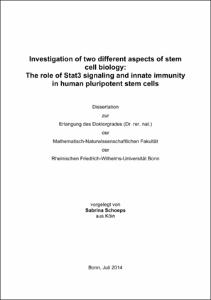Investigation of two different aspects of stem cell biologyThe role of Stat3 signaling and innate immunity in human pluripotent stem cells

Investigation of two different aspects of stem cell biology
The role of Stat3 signaling and innate immunity in human pluripotent stem cells

| dc.contributor.advisor | Edenhofer, Frank | |
| dc.contributor.author | Schoeps, Sabrina | |
| dc.date.accessioned | 2020-04-20T18:51:42Z | |
| dc.date.available | 2020-04-20T18:51:42Z | |
| dc.date.issued | 08.01.2015 | |
| dc.identifier.uri | https://hdl.handle.net/20.500.11811/6391 | |
| dc.description.abstract | Human pluripotent stem cells (hPSCs) hold great promises as a model for development as well as a source for cells in regenerative medicine. Although hPSC research came into focus in the last decade, many aspects of the biology of hPSCs still remain unclear. Maintenance of pluripotency in murine pluripotent stem cells (mPSCs) depend on LIF-activated Stat3 signaling, whereas human PSCs appear not to require activation of this signaling pathway. In order to investigate the potential role of Stat3 signaling in hPSCs, cells were treated with a chimeric fusion protein (“IL- 6/sIL-6R”). The chimeric fusion protein is supposed to be a potent LIF agonist and thus Stat3 signaling activator. While it was reported before that hPSCs can be maintained pluripotent in suspension cultures in the presence of the chimeric protein, here IL-6/sIL-6R failed to maintain pluripotency in adherent cultures. Activation of Stat3 signaling could be observed neither at protein nor at mRNA level. To further analyze the role of Stat3 in hPSCs, a targeted gene inactivation should be established. Classical DNA transfection methods did not lead to an efficient editing. Previously, synthetic mRNA could be transfected into hPSCs with an efficiency up to 78%. Therefore, synthetic Transcription Activator-like Effector Nuclease (TALEN) mRNAs targeting the Stat3 locus were generated. Synthetic TALEN mRNAs edited the hPSC genome with an efficiency of 5%. In order to improve efficiencies, transfection with several types of synthetic mRNAs should be investigated. Synthetic mRNAs usually contain modified nucleotides in order to prevent innate immunity activation. In order to investigate if innate immunity plays a role in hPSCs, it was tested whether synthetic mRNAs without modified nucleotides (“unmodified mRNA”) can be used. As a proof of principle, hPSCs and their derivatives lt-NES cells (multipotent neural precursors) were transfected with unmodified GFP mRNA. Surprisingly, the average efficiency (51.57% for hPSCs; 43.63% for lt-NESCs) was even higher than for transfection with modified GFP mRNA (41.83% for hPSCs; 28.87% for lt-NESCs). Furthermore, the fluorescence of the translated protein appeared to be stronger. Human fibroblasts, representing somatic cells, could be transfected more efficiently (59.57%) with GFP mRNA synthesized with modified nucleotides. Unmodified GFP mRNA transfection resulted in low efficiency (42.08%) and weak fluorescence intensity, most likely due to innate immunity responses. In order to test whether attenuated immune response is the reason for accessibility for unmodified mRNAs, the innate immunity associated Interferon signaling was blocked using the inhibitor B18R. Inhibition of Interferon signaling in human fibroblasts resulted in an increase of efficiency from 32.5% up to 59.35% when unmodified mRNA was transfected. Moreover, fibroblasts expressed higher levels of IFNβ upon transfection with unmodified mRNA compared to hPSCs and lt-NES cells. Together, this let suggest that the IFNβ mediated immune response is attenuated in multi- and pluripotent cells. These findings may be of interest for further applications of synthetic mRNAs in hPSCs. For example, generation of unmodified synthetic TALEN mRNAs should lead to improved genetic engineering. | |
| dc.language.iso | eng | |
| dc.rights | In Copyright | |
| dc.rights.uri | http://rightsstatements.org/vocab/InC/1.0/ | |
| dc.subject | Stammzellen | |
| dc.subject | Pluripotenz | |
| dc.subject | Stat3 | |
| dc.subject | synthetische mRNA | |
| dc.subject | innate Immunität | |
| dc.subject | stem cells | |
| dc.subject | pluripotency | |
| dc.subject | Stat3 | |
| dc.subject | synthetic mRNA | |
| dc.subject | innate immunity | |
| dc.subject.ddc | 570 Biowissenschaften, Biologie | |
| dc.subject.ddc | 610 Medizin, Gesundheit | |
| dc.title | Investigation of two different aspects of stem cell biology | |
| dc.title.alternative | The role of Stat3 signaling and innate immunity in human pluripotent stem cells | |
| dc.type | Dissertation oder Habilitation | |
| dc.publisher.name | Universitäts- und Landesbibliothek Bonn | |
| dc.publisher.location | Bonn | |
| dc.rights.accessRights | openAccess | |
| dc.identifier.urn | https://nbn-resolving.org/urn:nbn:de:hbz:5n-38706 | |
| ulbbn.pubtype | Erstveröffentlichung | |
| ulbbnediss.affiliation.name | Rheinische Friedrich-Wilhelms-Universität Bonn | |
| ulbbnediss.affiliation.location | Bonn | |
| ulbbnediss.thesis.level | Dissertation | |
| ulbbnediss.dissID | 3870 | |
| ulbbnediss.date.accepted | 02.12.2014 | |
| ulbbnediss.institute | Mathematisch-Naturwissenschaftliche Fakultät : Fachgruppe Molekulare Biomedizin / Life & Medical Sciences-Institut (LIMES) | |
| ulbbnediss.fakultaet | Mathematisch-Naturwissenschaftliche Fakultät | |
| dc.contributor.coReferee | Schorle, Hubert |
Dateien zu dieser Ressource
Das Dokument erscheint in:
-
E-Dissertationen (4118)




